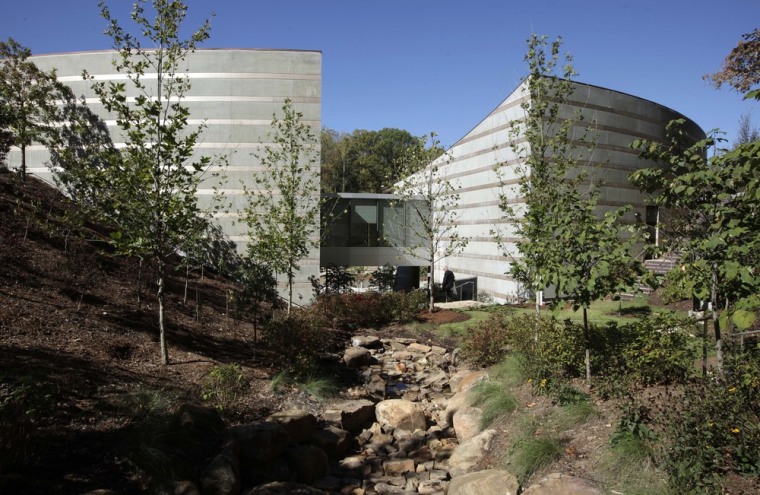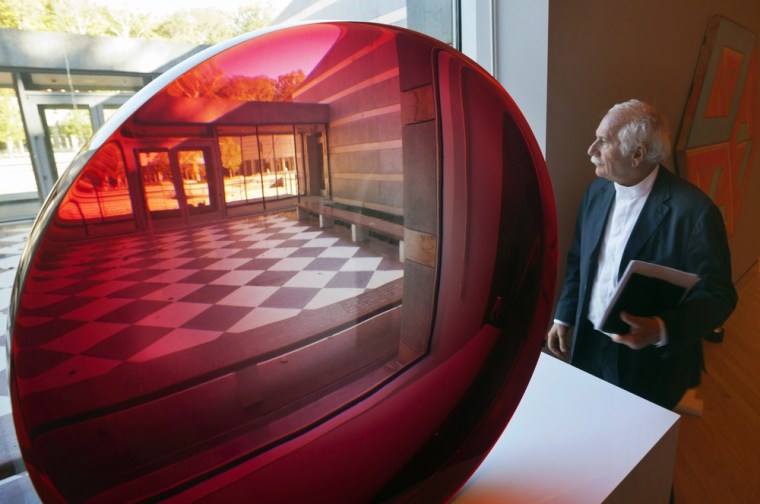As an heir to the Wal-Mart fortune, Alice Walton had the means to buy almost any piece of art on the market. So she scooped up one masterpiece after another: an iconic portrait of George Washington, romantic landscapes from the 19th century, a Norman Rockwell classic.
She amassed an enviable collection of treasures spanning most of American history, and now it's about to go on display in an unlikely place, a wooded ravine in a small city in northwest Arkansas.
The Crystal Bridges Museum of American Art is regarded as the nation's most important new art museum in a generation, offering the type of exhibits more commonly found in New York or Los Angeles. But this hall of paintings is taking shape in Bentonville, a community of 35,000 people best known as home of Wal-Mart Stores Inc. headquarters.
Walton's collection provided a "sort of instant museum," said Henry Adams, an art history professor at Case Western Reserve University in Cleveland. Rather than starting with a small collection and slowly expanding, Crystal Bridges will be fully formed from day one.
"You usually don't have a museum that appears out of nowhere," said Adams, who ranked the new place "somewhere between the top and the middle" of American museums.
When the museum opens Nov. 11, many of the paintings will be on public display for the first time because Walton bought them from private collections.
In the case of public art, Walton's acquisition efforts drew howls from some art lovers and critics on the East Coast, who bemoaned the notion that cherished works were being commandeered for display in an Ozark mountain town.
But experts say that story has been told before.
"Think of how the owners of the great collections in Europe and England must have felt at the beginning of the 20th century, when a lot of their art was coming into this country," said David M. Sokol, art history professor emeritus of the University of Chicago.
At the time, industrialists such as Henry Clay Frick and Andrew Carnegie used their fortunes to acquire fine art from wealthy Europeans, many of whom sold their paintings to sustain lavish lifestyles.
Ties to the region
One piece that provoked controversy was Asher Durand's masterpiece "Kindred Spirits," a dreamy depiction of two men in the Catskill Mountains that had been displayed for generations at the New York Public Library. Walton bought it in 2005 for a reported $35 million, sparking an outcry that the library had cast off a beloved part of its history.

She also acquired a Thomas Eakins portrait of a medical professor for a reported $20 million from Thomas Jefferson University.
Much of the art has deep ties to the region. The collection includes works by painter and muralist Thomas Hart Benton, grandnephew of Sen. Thomas Hart Benton of Missouri, the strident advocate of Manifest Destiny for whom Bentonville was named in the 1830s.
Walton was an art collector long before she proposed opening a museum, and she started buying specifically for the project in 2005. Her plan was to create something important for her hometown, a community that has more than doubled in size since 1990, mainly because of Wal-Mart, which has enticed many of its suppliers to open offices here.
Walton sought expert help with her purchases. She was advised by John Wilmerding, a former senior curator and deputy director of the National Gallery of Art in Washington. He also sits on the museum's governing board.
Crystal Bridges will have about 440 works on display. About 800 more are in storage, available to freshen the permanent collection, to put in special exhibitions or to be loaned to other institutions.
The museum is a 10-minute walk through the woods from Bentonville's downtown square, on 120 acres that have long been owned by the Walton family. The tract includes 3½ miles of trails.
"There aren't many places where you can go and experience this glorious park setting, this natural landscape, and then discover a great museum both architecturally and collection-wise," Director Don Bacigalupi said.
Walton, 62, is the youngest of Wal-Mart founder Sam Walton's four children. She's listed by Forbes magazine as the 10th wealthiest American, with a fortune of $20.9 billion.
She declined to be interviewed and has never revealed how much she spent on the complex. But the museum received an $800 million endowment from the Walton Family Foundation. And thanks to a $20 million grant from Wal-Mart, it won't charge a planned $10 admission fee.
Hidden gem
The inaugural exhibition, titled "Celebrating the American Spirit," will take visitors on a tour of important moments in the nation's development.
Visitors first encounter portraits of Revolutionary War figures in the colonial-era gallery, then move on to renderings of early settlers and American Indians, followed by paintings from the Civil War period.
Norman Rockwell's "Rosie the Riveter" from World War II is also there, as are paintings that reflect the civil rights era.
The galleries themselves blend natural and artificial light, a key element of architect Moshe Safdie's design.
Glass-enclosed corridors run between buildings, providing wide views of the grounds, including a stream fed by three springs. One of the springs, Crystal Spring, gives the museum its name.
For out-of-state visitors, the trip won't be short or simple. Bentonville is a two-hour drive from the nearest major airport in Tulsa, though the nearby and growing Northwest Arkansas Regional Airport is just a few miles from town.
But tourism officials expect the museum to become an even more popular landmark than the $160 million Clinton Presidential Center, which opened in 2004 and help revitalize downtown Little Rock, even after the recession drove tourists away in neighboring states.
Walton has planned for growth, telling The New York Times that she committed to the project only after getting the backing of her nieces and nephews. Walton has no children.
Andrew Walker, director of the Amon Carter Museum in Fort Worth, Texas, said it's not hard to imagine art lovers from across the world arriving at the regional airport on their way to Crystal Bridges.
A hotel is scheduled to open in about a year, specifically to cater to well-heeled museum visitors.
"It's a kind of an interesting moment" to see if the region grows into a major art center, Walker said. "We may not always see it as a small destination."
